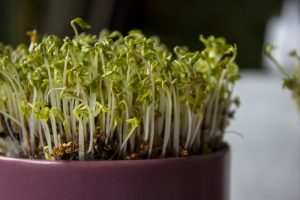Feeding The Masses With Indoor Farming
Food insecurity happens when the people it affects do not have consistent access to nutritious foods. Then, the problems span from stunted growth in childhood to obesity because people cannot get enough nutrient-rich, healthy food to maintain an ideal body weight.

Traditional farming can help alleviate some food insecurity, but the agricultural industry is heavily dependent on Mother Nature. Unusual weather patterns, poor soil conditions and invasive pests are some of the many things that can cause farmers to have disappointing growing seasons. There’s also the reality that some areas of the world do not have the climates necessary for producing some types of food, and that problem could get worse due to global warming.
So, what if it were possible to take all those outdoor variables out of the picture? That’s happening already thanks to an increasing interest in indoor farming.
Growing Things Vertically
Indoor farming is also called greenhouse farming. Discussions surrounding either of those terms often bring up the concept of vertical farming. It involves growing crops in vertically orientated stacks. This method allows for practically utilizing the available space. Moreover, parties in the vertical farming industry typically use sensors that detect the precise amounts of light, water and other essentials that the crops need to grow.
Taking this approach avoids the waste and uncertainty that can accompany traditional farming. AeroFarms, located in New Jersey, is one of the largest indoor farms. It substitutes LED lights for the sun and uses a specialized cloth instead of soil. Plus, the operation reportedly uses up to 95% less water than standard methods of farming because it delivers a mist of water and nutrients to the root structure.
Other vertical farms operate in similar ways, and their overall methods result in shortened growing times. It’s also worth noting that although the exact statistics vary, an acre of vertical farming could produce as much as a conventional farm that’s at least ten times larger.
Population Growth Is a Pressing Matter
Researchers understand that there’s no time to waste when figuring out how to feed the world’s population. Some estimates say that as the global population grows from 7.3 billion to 9.6 billion people by 2050, we’ll need to produce 70% more food to feed them all. LED lights are particularly advantageous in indoor farms because they allow offering dynamic light spectrums for individual plants. Sunlight is comparatively unpredictable.
But, customizable light is not the only aspect of indoor farming that could make it a feasible way to feed future generations. Some indoor farms use robots to manage many of the necessities. Research shows that labor costs represent as much as 80% of an indoor farm’s operating expenses, but many are using automation to keep costs down. Doing that could help tackle the problem of aging farmers contributing to a labor shortage.
Vertical Farms Help Solve Problems With a Lack of Land
When people bring up matters related to population growth, they often talk about how the increase of people on the planet makes it more difficult for those individuals to secure housing. In the agriculture sector, the opposite problem can arise, whereby an uptick of buildings for houses and offices leaves less land for agricultural development.
Indoor farms address that problem since they can exist inside of or on buildings — such as in one case where a former warehouse in Brooklyn now has a rooftop garden. Then, in the Sunqiao district of Shanghai, vertical greenhouses are integrated parts of the city, showing that farms can thrive without vast expanses of land.
Dealing With the Sustainability Challenge
Vertical farms offer higher yields than outdoor farms, and they’re compatible with urban environments. Many companies also sell compact indoor growing solutions for households, and those product manufacturers took inspiration from the large-scale indoor farms. All of those things are good news for fixing food insecurity.
But, critics point out that some indoor farms are not always sustainable options due to the energy required for things like climate control. That’s a valid argument, but people need to realize that no single solution will completely encompass the issue related to both food insecurity and sustainability.
As mentioned earlier, indoor farms use less water than traditional farms. Plus, they typically don’t require pesticides, which is another advantage for the planet. If enough indoor farms meet food availability needs, it’s also possible that produce would not need to travel as far to reach the people who eat it. That’s a sustainable outcome, too.
The possible downsides of indoor farms should merely be reminders of how solving the problem of feeding the future should take sustainability into account. Then, the results could mean that more people have access to the food they need, and the planet gets the necessary protection.

